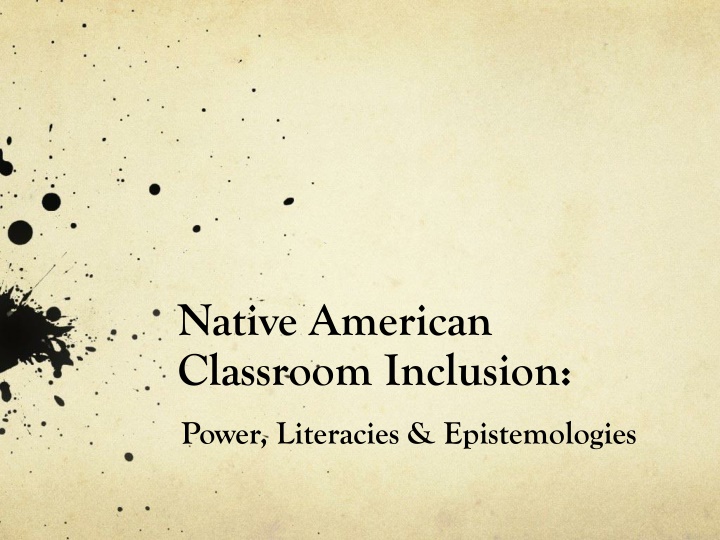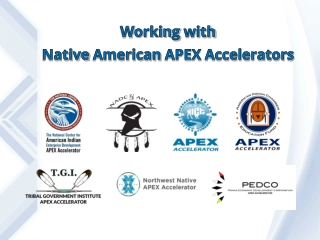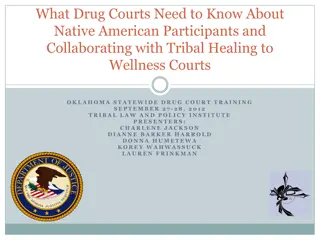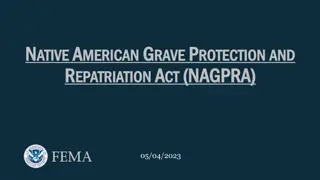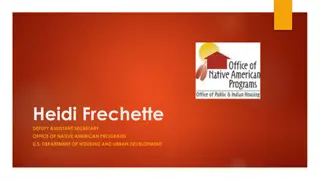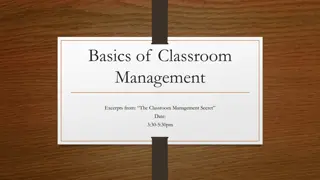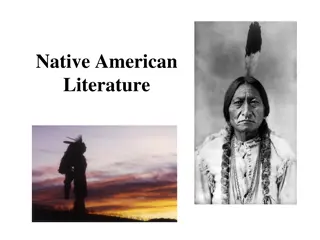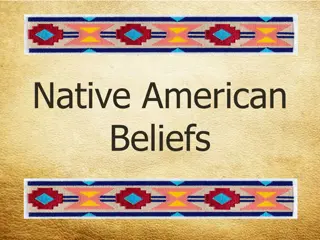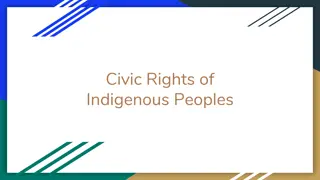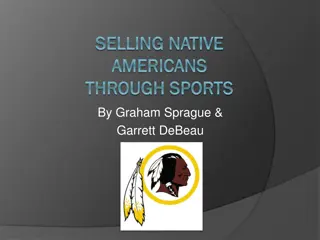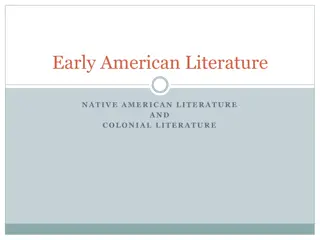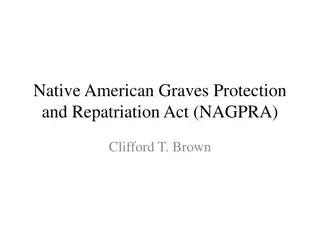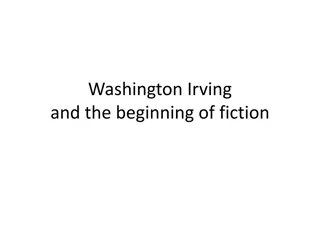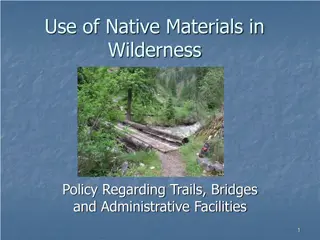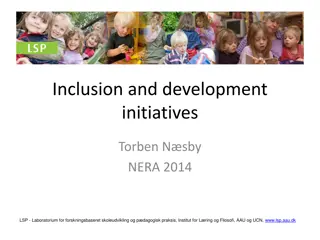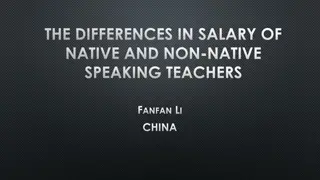Native American Classroom Inclusion: Power & Literacies
Complexities of Native American representation in classrooms, delving into power dynamics and literacy challenges. Reflect on Western epistemologies and Critical Race Theory in educational contexts
Download Presentation

Please find below an Image/Link to download the presentation.
The content on the website is provided AS IS for your information and personal use only. It may not be sold, licensed, or shared on other websites without obtaining consent from the author.If you encounter any issues during the download, it is possible that the publisher has removed the file from their server.
You are allowed to download the files provided on this website for personal or commercial use, subject to the condition that they are used lawfully. All files are the property of their respective owners.
The content on the website is provided AS IS for your information and personal use only. It may not be sold, licensed, or shared on other websites without obtaining consent from the author.
E N D
Presentation Transcript
Native American Classroom Inclusion: Power, Literacies & Epistemologies
The Indian survived out open intention of wiping them out. And since the tide has turned they have even weathered our good intentions toward them, which can be more deadly. --John Steinbeck
What & How We Know Often Fall Semester, I heard colleagues say that Reading Tommy Orange s There There was challenging, and it was, but the challenges were not due to its Native American Author, the narratives of Native American people, nor that it ends, as it began with slaughter, but because Western Epistemology and literacy are ill-equipped to make sense of a story not its own.
Color Blind Literacy : Who Can and Cannot Know Western approach to literacy, New Criticism, a formalist approach that views the text as an object separate from context, is easily recognizable as the most common method of literary analysis in US schools (qtd Borsheim-Black and Tatiana Sarigianides 72). It focuses on close reading and examination of literary elements, such as theme, plot, character, and symbol. The problem with this method of literary analysis is that ignores issues of race, to include Whiteness.
Critical Race Theory Majority White Teaching Force working in majority-minority schools White-Dominant educational context in which currently or in the past student demographics and communities are predominantly White CRT assumes racism is endemic CRT challenges colorblindness and Abstract Liberalism CRT values the voices of experiences of people of color CRT prioritizes Social Action CRT considers racial identity in interpretation of text
https://teachingwhilewhite.org/podcast/2018/8/18/white- fragility-part-one https://teachingwhilewhite.org/podcast/recoveringthevoic eofnativeamericansinschool
Massacre as Prologue A series of successful massacres, extermination , prologue to the conclusion At Sand Creek, we heard it said that the mowed us down with howitzers. They did more than kill us. The tore us up. Mutilated us. Broke our fingers to take our rings, cut off our ears to take our silver, scalped us for our hair They tore unborn babies out of bellies, took what we intend to be, our children before the were children, babies before they were babies, they ripped them out of our bellies. The broke soft heads against giant tees. Then the took or body parts as trophies. (8)
The Massacre of Culture Identity Destruction of of identity through education, assimilation and appropriation
Culture The system of shared beliefs, values, customs, behaviors, and artifacts that the members of society use to cope with their world and with one another, and that are transmitted from generation to generation through learning (Littlebear, p.90).
Naturalization Suggests that racism is a natural occurrence. These ideas suggest biological bases, not racism, as an explanation (Borshem-Black and Sarigianides p.77). [For example, associating alcoholism with Native Americans. There is no evidence that Native Americans suffer from alcoholism more than any other ethnicity]
Abstract liberalism Colorblindness using values of liberalism, like equal opportunity, meritocracy, individualism, or free choice, and turning them around to explain race related issues in ways that suggest inequality is a result of individual choices people make in their life and ignoring the role of colonization and systemic racism in the lives of Native Americans. [For example, students were able to question myths regarding the origin of the US but unable to connect colonization with contemporary conditions Native Americans face].
Minimization The type of color blindness suggest that racism is not as bad as it once was, that it no longer a significant factor in the lives of native Americans or people of color
Cultural Racism Blames characteristics of racial group as explanation for inequality [poor parenting, lack of discipline, drive, rigor]
Invisibility What most people in this country know or think they know about Native Americans is rooted in myths, stereotypes and half-truths. Information they have received since birth from movies, television, the media and school lessons has created a false narrative (or commonly accepted story) about historic and contemporary Native Americans and tribes. From a young age, most people in the United States have been immersed in the current dominant narrative about Native peoples. It is a largely false and deficit- based narrative, meaning it focuses on challenges and weaknesses real, assumed or exaggerated rather than being based on strengths and opportunities. These narratives are almost always created by non-Native people, often with the intention to oppress Native nations, peoples and cultures. Sometimes these narratives use outright negative stereotypes. Other times they create stories that seem positive at first but that actually reinforce myths by romanticizing Native cultures and implying that all Native Americans are the same. (Think about Disney s submissive Pocahontas or the idealized Native American characters in Dances with Wolves.)
Invisibility Faulty history lessons, media reports and rumors leave people with the false assumption that individual Native Americans are not U.S. citizens, receive money from the government, don t pay taxes, are rich from casinos and/or go to college for free (all untrue). Positive stereotypes blend many unique tribes into one Native American persona that is perceived to be committed to family and culture, spiritual and mystical, resilient through historical challenges, fiercely protective of the land, and patriotic to the United States. Non-Natives often hold positive and negative stereotypes at the same time: Native peoples living in poverty and rich from casinos; resilient and addicted to drugs and alcohol; the noble warrior and savage warrior. These assumptions and contradictions are alive and well thanks to sports teams and consumer products that continue to use derogatory Native American themed mascots, which some people defend as honoring Native Americans (they don t). Schools teach biased and revisionist history, while news media report only on disparities and do not use Native reporters to tell stories of strength. The list goes on and on. Well-meaning allies and sometimes even organizations serving Native Americans often unintentionally spread this false narrative by focusing on deficits rather than assets in an attempt to build support for funding, policies and programs (Fields (2006)
Isolation Isolation: 78% of Native Americans live off-reservation, and 72% live in urban or suburban environments (Whittle, J. (2017)The Guardian).
Tokenization Are native people depicted as stereotypically alike or like Whites with brown faces? Are Native people depicted as genuine individuals? (Slapin, et.al., 12).
Stereotypes: Are Natives portrayed as savages, primitive craftspeople or simple tribal cultures, now extinct? (Slapin (1992) 8) Looking for Stereotypes: Are native cultures oversimplified and generalized? Are native people all one color, one style? Is the art a mishmash of generic Indian designs? Are there insulting overtones to the language? Are racist adjectives used to refer to Indian peoples? Is the language respectful?
Look for Distortion of History Is there manipulations of words like victory, Conquest, or massacre to justify Euro-American conquest of the Native homelands? Are Native Nations presented as responsible for their own disappearance? Is the US government only trying to help? Is history put in the proper perspective: The Native struggle for self- determination and sovereignty against the Euro-American drive for conquest (Slapin, et. al., 13). Does the story encourage children to believe that Native peoples accepted defeat passively? Does the story show the ways in which Native peoples actively resisted the invaders? (Slapin, et.al., 14)
Look at Lifestyles Native American cultures presented in condescending manner, paternalistic distinctions between them and us rather than focusing on respect for Native peoples and understanding of the sophistication and complexity of their societies. (Slapin, et.al., 16) Look at the Lifestyles Native peoples discussed in the past tense only, support the vanished Indian myth; the past unconnected to the present, rather than continuity of cultures represented, with values, religions, morals, an outgrowth of the past, and connected to the present (17). Culture portrayed in a distorted or limited way. Religions described as superstitions, with backward or primitive connotations, rather than Indian religions and traditions described accurately, within the context of their civilizations (Slapin, et.al., 18) Is there an ethnocentric Western focus on material objects, such as baskets, pottery, rugs? Does the writer show an understanding of the relationship between material and non-material aspects of life? (Slapin, et.al., 19).
Look at the Dialogue Do the People speak in oratorical style of the noble savage? Do the people use language with consummate and articulate skill of those who come from an oral tradition (Slapin, et.al.,21)
Look for Standards of Success In modern times, are Indian people portrayed as childlike and helpless? Does a White authority figure pastor, social worker, teacher know better than Native people themselves what is good for them? Are Indian children better off away from their families? Are Native Adults seen as mature individuals who work hard and make sacrifices, in order to take care of their families, and for the well-being of the people? Do Native people and their communities contrast unfavorably with the norm of white middle-class suburbia? Are Native people and their communities seen as their own cultural norm? (Slapin, et.al., 22-23). Does it take white standards for Native people to get ahead? Are Native values of hard work, sharing, honesty, and courage seen as integral to growth and development? (Slapin, et.al.,24).
Look at the Role of Women Are women completely subservient to men? Do they do all the work, while the men loll around, waiting for the next hunt? Are Women portrayed as the integral and respected part of Native societies that they really are? (Slapin, et.al., 25).
Look at the Role of Elders Are Elders treated as a dispensable burden upon their People to be abandoned in times of trouble or famine; petulant demanding, nagging, irrigating, feeble and boring? Are Elders treated as the loved and valued custodians of a People s history, culture, and lifeways? Are they cherished in the words of the speaker as they were and are in the reality of the lives of the people? (Slapin, et.al.,26).
Two Paths Toward Indigenizing the Curriculum Finding the Indian in the curriculum. This is the most common approach. It assumes that the current materials and methods can be replaced or enhanced with Indian materials and methods to still meet the appropriate standards. Finding the curriculum in the Indian. This is more uncommon. It assumes that we start with Indian ideas and discern how they meet the appropriate standards. Reinhardt, M. (2005)
CREDE Standards for Effective Pedagogy (As adapted from: CREDE, 2011) Teachers and students working together on an American Indian focused joint productive activity Developing language and literacy skills (including Native and non-Native) across the curriculum while focusing on American Indian concepts Connecting American Indian focused lessons to students lives Engaging students in challenging lessons focused on American Indian concepts Emphasizing dialogue about American Indian concepts over lectures Teachers and students modeling American Indian behavior, thinking, processes and procedures and putting them into practice Students generating and directing activities focused on American Indian themes
American Indian Curriculum Materials Checklist (Cont.) Generalizations and Specificity: Tribes are not clumped together. If they are grouped with other tribes, it is done so appropriately based on shared concerns or backgrounds. Invisibility, Tokenization, Fragmentation, and Isolation: Concepts, tribes, and people are included in a robust manner when appropriate, not tokenized, fragmented, or isolated within the materials. Stereotypes: Can be positive, or negative, and both can be damaging to self- image and relationships. Perspectives: Indian perspectives are included and may be shown in contrast to non-Indian perspectives. Unreality: Negative concepts are not glossed over or excluded. Friendly Wording: Anti-Indian biased/loaded words are not used.
American Indian Curriculum Materials Checklist (As adapted from: Cubbins, 2000; Lindala, 2013; Reinhardt & Maday, 2005; Sadker & Sadker, 1982; and Slapin & Seale, 2006) Labels and Identity Construction: Labels are used appropriately and identities are used as constructed by Indians themselves. Cultural and Linguistic Accuracy: Cultural and linguistic references are accurate and have been authenticated by the appropriate tribal groups. Historical Accuracy: Historical references are accurate to the time period and have been authenticated by more than one source. Legality and Authority: Authorship and illustrator credentials clearly indicate if the materials were created by an American Indian in accordance with PL 101-164 of 1990 the Indian Arts and Crafts Act, and if this work was completed for, or on behalf of, an Indian tribe or other entity. Sources and Credibility: All sources of information are clearly indicated and have been cited or recommended by other trustworthy sources. The content has not been misappropriated, or bastardized.
Native knowledge is defined through Story & Community. To understand There There from a Native perspective requires understanding Native epistemology and literacy or at least acknowledging plurality of epistemology and literacy (Epistemologies and literacies).
Daniel Wildcat & Honor "American Indian metaphysics has the advantage of framing all questions of knowledge as fundamentally moral questions that literally reside in our everyday life...We must not avoid examining so-called economic, political and social aspects of our lives as part of larger moral questions and what it means to be indigenous today. ...Living with honor is just as important, if not more important, than living with freedom. Honor noun high respect; great esteem. adherence to what is right or to a conventional standard of conduct. "I must as a matter of honor avoid any taint of dishonesty"
Each Narrative Records an Oral History Each Narrative raises a different pressing issue for Urban Native Americans, which might be missed given a reader s cultural literacy skills, and epistemological orientation.
Dene Oxendenes character speaks to meaning of the title There There, as well as the origin of the project: This all started for me when I was thirteen. My uncle died and, sort of, I inherited the work he started. What he did, what I want to do, is to document Indian stories in Oakland. I want to bring something new to the vision of the Native experience as it is seen on the screen. We haven t seen the Urban Indian story. What we ve seen is full of the kinds of stereotypes that are the reason no one is interested in the Native story in general, it s too sad, so sad it can t even be entertaining, but more importantly because of the way it s been portrayed, it looks pathetic, and we perpetuate that, but no, fuck that, excuse my language , but it makes me mad, because the whole picture is not pathetic, and the individual people and stories that you come across are not pathetic or weak or in need of pity, and there is a real passion there, and rage, that s part of what I m bringing to the project (40).
Blue: Blue s narrative spoke to Native women the origins, causes of the problem of violence against Native American. Although 4 of 5 women experience violence, the absence of academic research was most distressing and notable. Most research regarding missing Native women and violence against Native women was provided by individuals championing research making violence against Native women an individual Nation Savanna's Act, Violence Against Women's Act 2019 & Restoring Tribal Sovereignty.
Geraldine, Blues friend says: Do you know how many Indian women go missing every year? It s not just Canada, it s all over. There s a secret war on women going on in the world. Secret even to us. Secret even though we know it (202).
Edwin Black, dreamt of becoming a writer, He earned a master s degree in comparative literature with a focus on Native American Literature. He wrote his thesis on the inevitable influence of blood quantum policies on modern Native identity, and the literature written by mixed-blood Native authors that influenced identity in Native cultures (72-73). Unemployed, he spent the days on the computer, researching topics associated with the brain. Edwin Black shares, There is not much out there for someone with virtually no work experience an MA in comp lit. I look. I sour (74). Until asked to research possible positions for candidates with an MA in comp lit, with a focus on Native American Literature, students were convinced this character was lazy. The issue raised by Edwin Blacks narrative is Indigenous Art, The problem with Indigenous art in general is that it s stuck in the past. The catch, or the double bind, about the whole thing is this: If it isn t pulling from tradition, ow is it Indigenous? And if it is stuck in tradition, in the past, how can it be relevant to other Indigenous people living now, how can it be modern? (77).
Student Reaction: The issue raised by Edwin Blacks narrative is Indigenous Art, The problem with Indigenous art in general is that it s stuck in the past. The catch, or the double bind, about the whole thing is this: If it isn t pulling from tradition, ow is it Indigenous? And if it is stuck in tradition, in the past, how can it be relevant to other Indigenous people living now, how can it be modern? (77). Students of color identified with text
Until researching for candidates with an MA in comp lit, with a focus on Native American Literature, students were convinced this character was lazy. Of all full-time faculty in degree-granting postsecondary institutions in fall 2017, 41 percent were White males; 35 percent were White females; 6 percent were Asian/Pacific Islander males; 5 percent were Asian/Pacific Islander females; and 3 percent each were Black males, Black females, Hispanic males, and Hispanic females.1Those who were American Indian/Alaska Native and those who were of Two or more races each made up 1 percent or less of full-time faculty. The racial/ethnic and sex distribution of faculty varied by academic rank at degree- granting postsecondary institutions in fall 2017. For example, among full-time professors, 54 percent were White males, 27 percent were White females, 8 percent were Asian/Pacific Islander males, and 3 percent were Asian/Pacific Islander females. Black males, Black females, and Hispanic males each accounted for 2 percent of full-time professors. The following groups each made up 1 percent or less of the total number of full-time professors: Hispanic females, American Indian/Alaska Native individuals, and individuals of Two or more races. In comparison, among full-time assistant professors, 34 percent were White males, 38 percent were White females, 7 percent were Asian/Pacific Islander males, 6 percent were Asian/Pacific Islander females, and 4 percent were Black females. Black males, Hispanic males, and Hispanic females each accounted for 3 percent of full-time assistant professors, while American Indian/Alaska Native individuals and individuals of Two or more races each made up 1 percent or less of the total number of full-time assistant professors. NCES.Ed.gov
Narrative Framework Values History Visibility Call to Action Fields, J. (2006).
What most people in this country knowor think they know about Native Americans: Is rooted in myths, stereotypes and half-truths received through movies, television, political and educational policy to, in part oppress Native nations, people and culture, but also to perpetuate a fictional self- image and identity. To equip students for success, when teaching literacy and knowledge, consider culture Indigenous people and communities still honor cultural guiding stories. Stories were the first way that humans stored information; they were the basis of the oral tradition of all Indigenous peoples. Since the beginning of human history, Indigenous cultures have ordered their understanding of human existence through how they remember and enact stories, using ritual, song, dance, and art (Cajete 2015 p. 95-96)
Bibliography Behrman, E. (2006). Teaching About Language, power, and text: A review of classroom practices that support critical literacy. Journal of Adolescent and Adult Literacy 49:6. Borsheim-Black, C. and S. Sarigianides (2019). Letting go of literary whiteness: Antiracist literature instruction for White students. New York: Teachers College, Columbia University.
